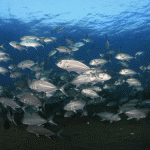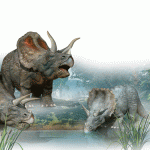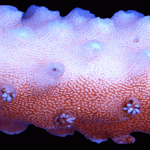
An absence of wolves has affected the food chain in Yellowstone National Park. Image: Nature Pl
In many places, the numbers of large predators have fallen by more than 90 per cent over the course of a few decades. Scientists are working feverishly to learn how this dearth of predators will affect the food chain.
Humans have a long history of usurping the habitats of large predators, as well as overhunting and overfishing them. Lion populations alone have fallen from about 400,000 to just 20,000 worldwide since the 1940s. Some populations of sharks have fallen by 90 per cent in the past few decades, and similarly alarming trends can be seen in populations of other large predators, including eagles.
In most of Western Europe and the United States the brown bear has long since disappeared; in the forests of Asia, there are only small, isolated populations of tigers. In some places, top predators have become so scarce that they have affected whole ecosystems and are threatening to alter food chains, changing the ecological order on land, at sea and in the air.
Reintroducing Predators
In many places, the loss of top predators started long before modern ecological theories and methods were introduced some 50 years ago, which makes comparing ecosystems with and without predators an extremely difficult task. Nonetheless, biologists can study the importance of top predators by observing ecosystems in areas where the animals have been reintroduced.
Yellowstone National Park has been a living laboratory ever since the first wolves (Canis lupus) were reintroduced in 1995 — they were completely wiped out in the area in the 1920s and had been absent from it ever since.
Before the grey wolf reintroduction, aspen, cottonwood and willow trees in many parts of Yellowstone were severely damaged because an army of herbivores, such as elk (Cervus canadensis), were eating them. These mammals damaged the park’s trees in such a way that the beavers of Yellowstone and elsewhere in the Rocky Mountains lost the building blocks for dam construction, leading to a local beaver extinction.
Beavers (Castor canadensis) are the most efficient landscape architects among animals, so as the beaver populations dwindled, innumerable small and large wetlands behind their dams disappeared.
More Wolves, More Trees
A few years after the reintroduction of wolves in Yellowstone, the first ecological effects of their presence emerged. Elk numbers fell, and the ones that survived became more and more cautious.
After the wolves reappeared, some animals began to avoid steep mountainsides, flooded forests and brush — although there was plenty of food in those areas, escaping from the “˜new predator’ would have been an extremely difficult task. Even when the elk grazed in flat landscapes, where it is easier to run away from predators, they spent a lot of time with their heads high, looking for wolves.
This increased attentiveness is the difference between life and death, but it limits the time that some animals can spend grazing. Beavers and small birds that nest in the trees are greatly benefitted by this trend.
The wolf effect
The wolves’ presence has affected not only elk, beavers, small birds and trees, but also the local scavengers. Ravens, eagles and coyotes (Canis latrans) get a welcome dietary supplement in the form of carcasses left by wolves, which helps them survive the cold winters.
Without wolves the availability of winter carcasses is unpredictable — during mild winters only a few deer die from starvation. Given that climatologists expect mild winters to increase as a result of climate change, scavengers may suffer without access to the carrion provided by wolves. In wolf-rich areas, most scavengers are supplied with carcasses all year round. The wolves, therefore, help scavengers adapt to climate changes.
Although coyotes also benefit from carcasses left behind by wolves, the increasing wolf population in Yellowstone has caused a shift in the smaller coyote population. Today, the number of coyotes in the national park has declined, and in the core wolf areas, there is, on average, one-third of the density of coyotes compared to other areas of Yellowstone. The wolf considers its “˜smaller cousin’ a competitor that must be killed — and coyotes have moved their dens to wolf-free areas of the park.
The coyotes are especially in danger during the mating season, because the wolves can easily track a female coyote’s burrow and cubs. Because coyotes hunt smaller prey than wolves, the numbers of prey often increase when wolves take over from “˜their cousins’.
Removing an animal, such as a coyote or wolf, from its habitat can lead to other unpredictable consequences. Coyotes help control numbers of both domestic and feral cats, which kill native birds. Removing coyotes from urban areas such as Los Angeles or Chicago could affect local avian populations. In western Texas, for example, the extermination of coyotes had completely different consequences. When the coyotes were removed from a research area with scattered bushes and grass, an open war over food broke out among the 12 rodent species of the area. Eventually, only a single rodent species, the kangaroo rat (genus Dipodomys), remained.
Problems at Sea
The lack of predators affects marine animals as well. In recent decades, biologists have recorded a marked growth of small predatory fish when the populations of large predatory fish collapsed because of overfishing. However, biologists are not always certain how far down the ocean food chain the ecological effect reverberates.
In parts of the Baltic Sea declining numbers of dominant predatory fish, such as pike and perch, create ripples throughout the ecosystem and cause certain algae to bloom. This happens because the lack of predators allows for the nearly unlimited growth of small fish, such as sticklebacks. Once there are more sticklebacks, there will be a tremendous decline of stickleback prey, including small crustaceans. In turn, these crustaceans live off algae and normally keep the algae populations under control, but when they disappear, the algae bloom. In the Black Sea, for example, the absence of top predators has had even more serious consequences for the ecosystem. Overfishing of dolphins and large predatory fish in the 1970s meant a massive increase of small, crustacean-consuming fish species. Fewer crustaceans fed off algae and caused large algae blooms. The lack of large marine creatures meant that fishermen emptied the Black Sea of small fish. This chain of events meant that a large ecological niche was empty, filled in a short time by jellyfish, which now dominate large parts of the Black Sea.
A shark’s tale
Populations of large sharks have fallen by more than 90 per cent, and the situation is just as severe for large tuna and other predatory fish.
The massive decline affects life further down the food chain. Between 90 and 99 per cent of 11 large shark species have disappeared in the Atlantic off the coast of the United States. All of these species hunt small sharks and rays, and biologists have recorded an increase in the populations of 12 out of 14 of the small shark and ray species. These, in turn, have decimated local stocks of commercially important molluscs.
Facing no predation, cownose rays in the northwestern part of the Atlantic Ocean assumed a new position at the top of the food chain. For several years, the number of cownose rays (Rhinoptera bonasus) increased by nine per cent a year, and today the population is up to more than 40 million.
Studies have shown that cownose rays can quickly decimate entire beds of Atlantic bay scallops. For example, in Chesapeake Bay, Virginia, the rays may consume up to 840,000 tonnes of scallops during the 100 days that they stay in the embayment. The commercial catch of scallops in the area has fallen to about 270 tonnes per year.
Farther to the south, overfishing has emptied most tropical coral reefs of top predatory fish; and the lack of predator control has caused a boom among smaller fish species and starfish, which are hunted by predators at natural coral reefs. In several places, the lack of top predators has probably contributed to an increase in the number of coral-eating starfish, as well as reducing the population of reef-building corals and algae.
The food crisis
Sharks and other fish are not the only top ocean predators whose existence is threatened by humans. The sea otter (Enhydra lutris) functions as a kind of ecological inspector of the seaweed forests of the North Pacific, but its numbers have declined drastically, due, in part, to the 19th century fur trade. In the 1800s, when fur trappers almost wiped out sea otters, the seaweed forests also disappeared. Sea otters have a healthy appetite for sea urchins, and as otter numbers dwindle, the latter blossom.
The sea urchins (Echinus melo) devour the seaweed forests, which are the habitat of fish fry. Without sea otters to control the sea urchins, huge seaweed forests, which calm the waves, protecting the coast from erosion and allowing high-nutrient particles to sink to the bottom, are destroyed.
Some conservation efforts helped bring back the otters, and therefore the seaweed and its ecosystem. But sea otters face another danger: lower fish stocks in the region have cut off the main food source for local seals and sea lions, which in turn were hunted by killer whales. Now killer whales (Orcinus orca) have begun to hunt sea otters, and the seaweed forests are once again at risk.
Problems in the Air
The top flying predators are also under pressure. Worldwide, populations of raptors, which includes eagles, vultures, hawks and owls, have declined because of destruction of habitats.
In recent years, biologists have discovered that the decline is also affecting places where the raptors have traditionally had plenty of prey and space. In Burkina Faso, Mali and Niger, four large eagle species outside special protection areas have declined 86 to 98 per cent over about a 30-year period, while another seven species may have disappeared altogether.
In western Kenya, raptors declined by 40 per cent in just three years, with vultures and other scavengers making up the bulk of the loss. Scientists think that the raptor declines are due in part to an increase in human population and the associated takeover of land and resources. In other cases, scientists suspect that some of the birds may be feeding on dead lions, hyenas and other predatory animals that were poisoned in an attempt to protect local livestock.
Biologists are studying how the decline of raptors affects the ecological order. A team of European biologists has found that territories with goshawks (genus Accipiter) and four owl species in the Italian Alps have a greater variety of trees, butterflies and small birds than similar woodlands without hawks and owls. The scientists speculate that the variety of species may mean a lot for an ecosystem’s overall biodiversity.
Biologists are trying to find out how missing top predators affect the food chains on land, at sea and in the air; consequences manifest in countless ways, depending on the composition of the ecosystems. Sometimes, the lack of top predators only influences the next step in the food chain, but it often sends shock waves down through the entire ecosystem and affects the presence of everything from medium-size predators and herbivores to the smallest algae.
Scientists hope that future research will explain more pieces of this ecological puzzle known as trophic cascade (addition or removal of top predators). Hopefully their efforts will lead to a concrete plan for the strategic reintroduction of predators in key places.
To get a copy of our March/April issue, just click here






